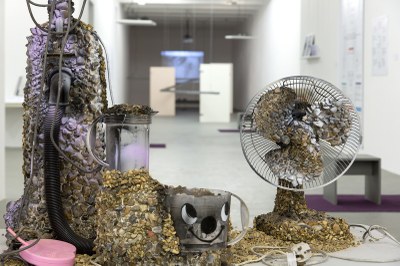Art collaborations & exhibitions
The Influencing Machine
November 2018 – January 2019
nGbK, Berlin
Curated by: Vladimir Čajkovac, Kristina Kramer, Bettina Lehmann, Sophie Macpherson, Tahani Nadim, Neli Wagner
Bots (from ‘robot’ and Czech ‘robota’, socage, forced labor) are inconspicuous computer programs that perform tasks automatically.
Bots manipulate the masses, turn ‘fake news’ into facts, supersede human labour, colonise our objects and lead us into temptation: Based on digital code, bots perform thousands of minute routines which supplement and at times displace human agency and labour, thus shaping virtual and analog structures. They are often given human features––names, voices, bodies on occasion. Yet even when remaining invisible, they are increasingly becoming part of our everyday.
“The Influencing Machine” examines these diffusions and formations. Clustered around a series of famous bots, the exhibition assembles contemporary artistic positions examining the automation and datafication of our life worlds and work environments. Here, bots are understood as socio-technical phenomena; their efficacies requiring and provoking novel and manifold relations and imaginations:
How do bots and data form politics? In what ways do they transform political orderings of participation, accountability and knowledge? Why do racist or sexist logics reproduce and intensify on digital platforms, social networks, and data-driven expert systems? What does it mean for the value of labour and, more generally, human agency if transactions, communication, and decisions are increasingly carried out by fully automated devices? Which cultural imaginations shape the design and function of human-machine interfaces?
The exhibition provides insights into the socio-material ecologies of this new influencing machine and seeks to problematize the figure of the bot beyond the dominant narratives of society and technology.
The publication “The Influencing Machine” is addressing the exhibition’s various questions, extending its focus to historical continuities and social contexts, with contributions by Geoffrey C. Bowker and Susan Leigh Star, Simone Brown, Wendy Hui Kyong Chun, Kashmir Hill, Lilly Irani, Lee Mackinnon, Tahani Nadim, Lucy Suchman, Cher Tan, and Neli Wagner.




Tote Wespen fliegen länger
Faktische und fantastische Reisen dreier Protagonisten aus den Sammlungen des Museums für Naturkunde Berlin
March - May 2015, Museum für Naturkunde Berlin
Tahani Nadim & Åsa Sonjasdottir
/Staub/Wespe/Samen
In dieser Ausstellung präsentieren die Wissenschaftssoziologin Dr. Tahani Nadim und die bildende Küns- tlerin Åsa Sonjasdotter faktische und fantastische Reisen von drei Protagonisten aus den Sammlungen des Museums für Naturkunde: einer Grabwespe, kosmischem Staub und Pflanzensamen. Hinter der scheinbaren Ruhe der Präparate verbergen sich bewegte Geschichten und Beziehungen. Sie rücken unser Verständnis vom Museum und von Natur in ein anderes Licht und regen zum Nachdenken an, wie wir mit unseren Welten umgehen. In drei Interventionen im Ausstellungs- und Sammlungsbereich werden die Umlaufbahnen dieser Dinge nachgezeichnet und erweitert, um den Verkehr zwischen Räumen, Zeiten und Ordnungen sichtbar zu machen. Dabei wird gefragt, wo Sammlungsobjekte her- kommen und wie sie ins Museum gelangen. Dem Aufruf der Wissenschaftsphilosophin Donna Haraway „stay with the trouble“ („folge den Schwierigkeiten“) folgend werden so kosmopolitische Probleme reflektiert, die sich durch diese Bewegungen eröffnen. 



